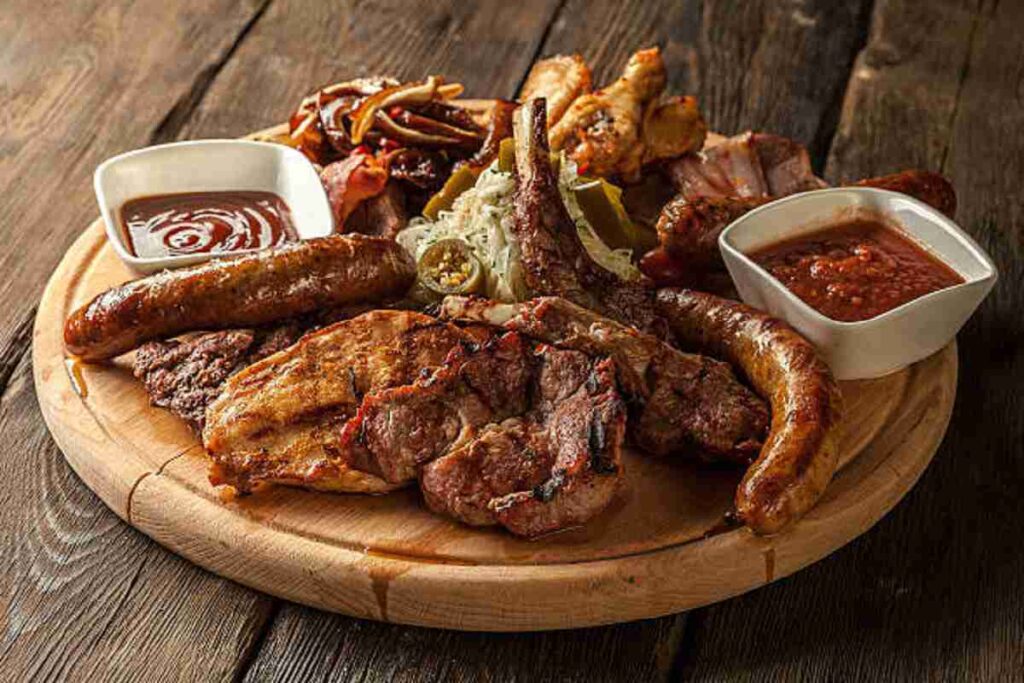The sizzling aroma of a freshly grilled platter of various meats and vegetables can instantly tantalize our senses, which is the allure of a mixed grill. In this article, we’ll look into its origins, variations, cooking techniques, health benefits, and much more about this classic culinary fusion dish Indian mix grill.
If you love experiencing an array of flavors all in one dish, It may just be for you. It features an impressive combination of beef, lamb, chicken, and pork meats along with vegetables for an irresistibly mouthwatering dish!
Table of contents

How to make Mixed Grill?
Indulge in the flavorful delight of a mixed grill, combining grilled meats and vegetables. Discover variations and Indian mix grill.
- Is a mixed grill a popular dish in a specific cuisine or region?
Mixed grill dishes are enjoyed in various cuisines and regions around the world, with different variations and names depending on the cultural influences and local traditions.
- How is a mixed grill cooked?
The meats in a mixed grill are usually seasoned with spices, herbs, or marinades, and then grilled to perfection
What is a Mixed Grill?
A Tandoori mixed grill refers to a culinary creation that typically consists of various grilled meats and vegetables. The dish is known for its diversity and can include cuts like sausages, steaks, chops, skewers, and kebabs. The meats are often accompanied by grilled vegetables like bell peppers, onions, zucchini, and mushrooms, adding a burst of color and freshness to the plate.

Mixed Grill
Equipment
- 1 Grill or Barbecue A grill or barbecue is essential for cooking the meats and vegetables for a mixed grill. It can be a charcoal grill, gas grill, electric grill, or even a stovetop grill pan, depending on your preference and availability.
Ingredients
Instructions
- In a bowl, whisk together the olive oil, lemon juice, Worcestershire sauce, soy sauce, honey, Dijon mustard, minced garlic, chopped fresh herbs, salt, and pepper. This will be the marinade for your mixed grill.
Video
Notes
History and Origins of Mixed Grill
The origins of the mixed grill can be traced back to different cultures around the world. While it’s challenging to pinpoint a specific time and place of its inception, the concept of combining different grilled ingredients has been a part of culinary traditions for centuries. In Mediterranean cuisine, for example, Indian mix grill have been enjoyed for generations, showcasing the diverse flavors of the region.
Popular Variations of Mixed Grill
The beauty of mixed grill lies in its versatility, allowing for various interpretations across different cuisines. Some popular variations include:
British Mixed Grill
The tandoori indian mix grill traditionally consists of sausages, lamb chops, bacon, and kidneys. It is often served with grilled tomatoes, mushrooms, and toast, making it a hearty and satisfying meal.
Middle Eastern Mixed Grill
In Middle Eastern cuisine, tandoori mixed grill are often referred to as “kebab platters” and feature succulent skewered meats like shish kebabs, koftas, and lamb chops. These are accompanied by grilled vegetables, rice, and aromatic sauces.
Asian Fusion Mixed Grill
Asian fusion mixed grill combine the flavors of various Asian cuisines. They may include marinated chicken satay, teriyaki-glazed beef skewers, shrimp, and an assortment of Asian vegetables. The dish is often accompanied by steamed rice or noodles.

Ingredients Used in a Mixed Grill
Ingredients:
- 5 chicken breasts: $10
- 5 lamb chops: $15
- 5 beef steaks (such as sirloin or ribeye): $20
- 10 sausages (pork or beef): $8
- 1 large onion, sliced: $1
- 1 bell pepper, sliced: $1
- 20 button mushrooms: $3
- 5 garlic cloves, minced: $0.50
- 2 tablespoons olive oil: $0.50
- 1 teaspoon paprika: $0.25
- 1 teaspoon dried oregano: $0.25
- Salt and pepper to taste: $0.25
- Lemon wedges for serving: $1
Nutrition Scheme (approximate per serving):
- Calories: 550
- Protein: 50g
- Fat: 25g
- Carbohydrates: 20g
- Fiber: 4g
Cooking Techniques for a Perfect Mixed Grill
To achieve a perfectly cooked mixed grill, it is essential to master the art of grilling. Here are some cooking techniques to consider:
Preparing the Grill
Before grilling, ensure that the grill is clean and properly preheated. This helps to prevent sticking and ensures even cooking.
Marination and Seasoning
Marinating the meats and vegetables beforehand enhances their flavor and tenderness. Use a blend of herbs, spices, oils, and acids like lemon juice or vinegar for margination.
Direct and Indirect Grilling
Different ingredients require varying cooking methods. Direct grilling is suitable for smaller cuts that cook quickly, while indirect grilling is ideal for larger cuts that require longer cooking times.
Direct and Indirect Grilling
Maintaining the right temperature throughout the grilling process is crucial. Adjust the heat or move the ingredients to different zones of the Tandoori mixed grill to ensure they are cooked to perfection.

Instructions
- Preheat your grill to medium-high heat.
- In a small bowl, mix together the olive oil, minced garlic, paprika, dried oregano, salt, and pepper to create a marinade.
- Place the chicken breasts, lamb chops, beef steaks, sausages, sliced onion, bell pepper, and mushrooms in a large bowl. Pour the marinade over the meat and vegetables, making sure to coat them evenly.
- Allow the mixture to marinate for at least 30 minutes, or refrigerate overnight for enhanced flavor.
- Once marinated, remove the meat and vegetables from the bowl, reserving any remaining marinade.
- Place the meat and vegetables on the preheated grill. The chicken breasts for about 6-8 minutes per side until they cook through and the center is no longer pink.
- .The lamb chops and beef steaks will take about 4-5 minutes per side for medium-rare, or adjust the cooking time according to your desired level of doneness. Cook the sausages until they are browned and cooked through, turning them occasionally.
- While grilling, you can brush some of the reserved marinade over the meat and vegetables to add more flavor.
- After cooking everything, take the meat and vegetables off the grill and place them on a serving platter. Let them rest for a few minutes before serving.
- Serve it with lemon wedges on the side for squeezing over the meat. You can also serve it with a side of salad, rice, or grilled vegetables.
Notes
- Mixed Grill Recipe:
- Includes chicken breasts, lamb chops, beef steaks, sausages, onion, bell pepper, and mushrooms.
- Marinate meat and vegetables in olive oil, garlic, paprika, oregano, salt, and pepper.
- Grill the meat until fully cooked and browned, adjusting cooking times for desired doneness.
- Serve with lemon wedges for added flavor.
- Nutrition Scheme:
- Per serving: approximately 550 calories, 50g protein, 25g fat, 20g carbohydrates, and 4g fiber.
- Note: These values are approximate and can vary depending on ingredients and cooking methods.
- Price Breakdown:
- The cost estimate for the cross-grill recipe is $61.75.
- Includes the cost of ingredients such as chicken, lamb, beef, sausages, vegetables, seasonings, and lemon wedges.
- Prices may vary based on location and market prices.
Remember, these notes provide an overview of the mixed grill recipe, nutrition scheme, and price breakdown.
FAQs
Yes, vegetarians can enjoy an Indian mix grill by incorporating plant-based alternatives like grilled tofu, tempeh, and vegetable skewers.
It can be a healthy option when prepared with lean cuts of meat, grilled vegetables, and portion control in mind. It provides a good source of protein and nutrients.
Q3: Can I prepare a grill indoors if I don’t have an outdoor grill?
You can use a stovetop grill pan or an indoor electric grill to prepare grilled food indoors.
While fresh vegetables are recommended, you can choose to use frozen vegetables if necessary.
Ensure that you thaw and pat them dry before grilling.
Absolutely! One of the great things about the hybrid grill is its versatility. You can tailor it to accommodate various dietary preferences or restrictions.
Yes, it is enjoyed in various parts of the world. It is particularly popular in Mediterranean, Middle Eastern, and South Asian cuisines.









